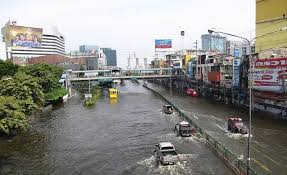Manage Floods – Grassroot Level.
In many of the urban agglomerations, including Mumbai-Thane , Delhi-NCR etc. and in flood-prone irrigated farmlands of Bihar , Gujarat & West Bengal, instantaneous surface water flooding is a big concern. There is a huge liability of restructuring affected areas and providing tangible solutions by the concerned Central Govt. (National Disaster Management Authority) and State Govt. (State Disaster Management Authority) bodies. But the real asset for instant flood-water management has to come from local bodies as well as us, the affected people.
A systematic and integrative assessment of ongoing and future flood-like situation is necessary. All this along with effective constructional measures need to be finished before the onset of another similar calamity. There are really a few things that can be done if a group of individuals from affected communities start taking the initiative.
1. Assess what kind of flooding has occured – fluvial (overflow of river or river-like feature), groundwater (exceedance of water table) , foul (sewer blockage), surface water (excessive rainfall)
2. Assess the flooding ‘hotspots’ in the area. These may be a few low lying areas where the water gets collected as a pond or open spaces which are susceptible to water inflow. If inhabited areas come within this range, measures need to be taken for either relocation or floodwater control.
3. Assess a rough measure of flood water that gets collected at the hotspot, along with its frequency of occurrence and intensity. How ? We may take data from PWD and meteorological department in case of a city or town, or for a smaller patch of land, we can measure depth of flooding/water logging and roughly estimate surface topography (land area, elevation, perimeter etc.)
4. There are a few good measures to be followed in case of each type of flood. If it is fluvial or surface water type, contour bunding or barricading is necessary by houses that lie on river bank. If this is not enough, a good strategy would be diverting the excess water to a Public Open Space (park, reservoir, uninhabited arable land etc.) via pumping or channelizing. Another alternative is to channel via highways, whose drainage is generally maintained by the highway authorities. Creating pits in POS and bounding them with walled structures from every side will help create a mini temporary pond where floodwater can be collected. The very POS can later be used as a recreational area in the dry season. If it is groundwater type , it is very important to know the elevation of the affected areas. In that way, excess groundwater can be removed via an alternate opening artificially created at an elevated ground, which can be further channelized. Another good strategy will be simple rainwater harvesting in case of milder situations.
Once the flood is controlled in the area, it becomes our own responsibility to maintain and repair the control structures or if not possible, inform the concerned authorities about the same. In addition to this, it is always a good idea to learn a few disaster management strategies that may be applied, keep ourselves updated about latest weather conditions and create our own action plan rather than depending on others when it is needed for real.




20 Comments. Leave new
Essential information to deal with the current crisis in assam and mumbai
Helpful points!
Informative!
Informative and helpful.. Good job..
Very helpful information. Good work.
Good article. Are these steps taken in anywhere in India?
I dont know about India, but in UK and Japan, they certainly do that. These ideas are actually implemented on a mass level in many counties of England.
Very Helpfull Topic 😀 .. Good Job
very informative!! well done
Well written
Somebody tell Mumbai about this. 😀
People Are aware of evrything.
Its just they dnt want to be the first one to take a step ahead.
Very vital information! Very good article!
well researched work
Very important article… Such issues are very common these days..
Informative and helpful
Informative!
Well written!
very inforative and helpful for many
Informative. Nice work!
Nice work!